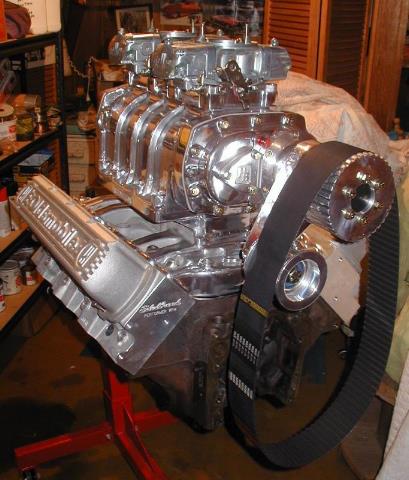2Loose
reliable source of info

Here's a project I've been slowly putting together for some time now, it's a work of love and if I never get to run it, that's ok!
My Dad was an Olds mechanic off and on most of his life. He had a '49 Olds he picked up in '51 and was constantly working on that motor to get more power out of it! Later it was a '57 Olds with a reworked 371 and the J2 (triple two barrels) option.
When my three kids were growing up I had a couple of big old Olds gunboats, they were cheap, dependable, roomy, great beach cars, full of sand, surfboards, fins and masks, towels, ice chests, my kids and half the neighborhood, rolling party wagons heading to the beach, kid style....
I paid $50 for this '67 Delta 88 4 dr with a 425 and th400, got several years of beach cruising use out of it and then parked it in my Olds junkyard:
When I finally parted it out and pulled apart the 425 motor in it, I found a forged (oem) crank and forged 7†rods in it. The motor stock is 4.125†x 3.975†bore and stroke. According to my Dad, this motor was known to easily and consistently do 7,000 rpm with the right valve train parts in it, and that was back in the 60’s….
I bored it to 4.155â€, decked it just enough to square and smooth it, had the crank reconditioned and polished, the rods beam polished and shot peened, got some JE 8:1 forged pistons, a reconditioned Don Hampton 6-71 blower set up for Olds, a girdle for the bottom end, and started putting it together.
This block is a 2 bolt main, so the main caps were machined for this girdle, the five pan bolt holes on each side were re-tapped to 3/8â€, and the girdle was fitted to tie the mains together and also to the block pan rails.
A pair of Edelbrock RPM Performer heads were conservatively ported for this setup, just to smooth out the flow and eliminate some obstructions:
Some health problems have slowed me down on this project, and a cam has not been selected as yet. My next step is to file fit the rings and get the pistons in there, by then I’ll have decided on a cam. I’ve talked to several cam manufacturers about a mild street blower cam, it seems most are recommending a fairly wide cam lobe separation, like 115 deg.
Just what I will end up putting this motor into had not been decided. I do have a pretty ratty ’55 that it would be fun to make into a gasser, but that has not been decided.
Something like this maybe? In black primer?:

I found a pair of used race demon 625's set up for a blower app (see first pix) on the internet, and an MSD distributor and ignition box, so I have most of what I need to put this together and get it running.
More later….
Aloha,
Willy
